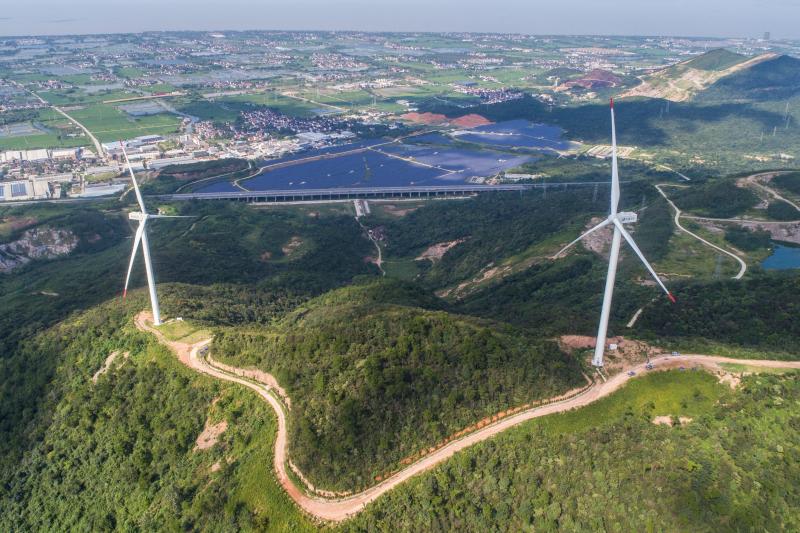China shows way as urgent action needed on global warming
- By Rachana Gupta
 0 Comment(s)
0 Comment(s) Print
Print E-mail China.org.cn, December 11, 2019
E-mail China.org.cn, December 11, 2019

A study by the United Nations meteorological agency WMO, published last month, states that heat-trapping greenhouse gases – carbon dioxide, methane, and nitrous oxide – have reached an unprecedented level in the atmosphere.
The global average of carbon dioxide concentrations reached 407.8 parts per million in 2018, a figure 2.3 ppm higher than the previous year. Similarly, the concentration of nitrous oxide and methane swelled to 331.1 parts per billion (123% above pre-industrial levels) and 1,869 parts per billion (259% of the pre-industrial levels).
The results came at a crucial juncture when extreme weather conditions due to climate change are turning into a new normal, impacting marine and land ecosystems.
On the one hand, monstrous wildfires are frequently wreaking the havoc in regions such as Brazil's Amazon rain forests, Australia, and the U.S., while on the other hand, the rising temperatures are rapidly melting-down the glaciers of polar regions such as Greenland and Antarctic peninsula.
Already, climate scientists have started raising the red flag of "the point of no return" and the approaching sixth mass extinction of life as a result of the human activities on the planet.
Thus, it is vital for the ongoing 2019 U.N. climate change conference, known as COP25, in Madrid, Spain, to achieve its target of effective implementation of the United Nations Framework Convention on Climate Change (UNFCCC) and the Paris Agreement.
In 2015, more than 200 nations under the Paris Agreement, pledged to keep the planet's temperature rise between 1.5 and 2 degrees Celsius from 2005 levels.
Since then, China, as one of the major stakeholders of the accord, has been pushing hard towards achieving its climate targets much earlier than promised. It has been deploying massive resources on numerous fronts to not only get rid of the environmental challenges domestically but also to help other parts of the world achieve their climate goals.
For instance, under the Paris Agreement, China pledged to cut down its greenhouse gas emissions per unit of GDP by 60-65% from 2005 levels while increasing the percentage of non-fossil fuels up to 20% of its total energy consumption by 2030.

It has already cut down its carbon emissions under this measure by 46% from 2005 levels. Meanwhile, a recent study published in Nature Energy journal projected that China could achieve the Paris targets well ahead of schedule as a result of rapid reduction in the power-plant emissions of sulfur dioxide, nitrogen oxide, and PM2.5 and 10 thanks to its introduction of ultra-low emissions standards.
Notably, between 2014 and 2017, these three significant pollutants shrunk by 65%, 60%, and 72% respectively. Also, the share of non-fossil fuels from 2017 to 2018 increased from 12% to 14.3% as the country's primary energy source.
Investment in China on renewable energy accounts for 45% of total global investment in this regard. Already, China has surpassed all other nations to become by far the world's largest producer, exporter and installer of wind turbines, solar panels, batteries, and electric vehicles.
It is not just investing more than the U.S., the EU, and India combined, but also innovating significantly in the field of clean energy. For example, China filed more than 150,000 renewable energy patents by 2016, almost 29% of the total patents filed worldwide in the sector.
Additionally, China launched a Green Development Coalition along with the other stakeholders under the Belt and Road Initiative in April this year, which is in line with the United Nation's sustainable development goals of 2030 and based on the principle of "construction and sharing."
Since 2014, China has invested heavily in the wind and solar PV projects with combined 12,622 MW capacity in the regions along the Belt and Road.
Moving on, the UN Environment Programme (UNEP) Emissions Gap Report, published in early November, highlighted that the global temperature has already swelled to 1.1 degrees above pre-industrial levels, and at this rate the planet's temperature could be higher by 3.2 degrees Celsius in 2100, dramatically exacerbating problems such as food, water, and land shortage. This scarcity could, in turn, trigger major social unrest.
Therefore, by looking at the critical climate situation and the alarming future projections, it is essential that clear deadlines and roadmaps for effective implementation of the Paris Agreement be achieved in the ongoing COP25 conference.
Rachana Gupta is an active blogger, poet and freenlance content writer. She is also the author of the book "To The Horizon We Indeed Sail".
Opinion articles reflect the views of their authors only, not necessarily those of China.org.cn.
If you would like to contribute, please contact us at opinion@china.org.cn.






Go to Forum >>0 Comment(s)